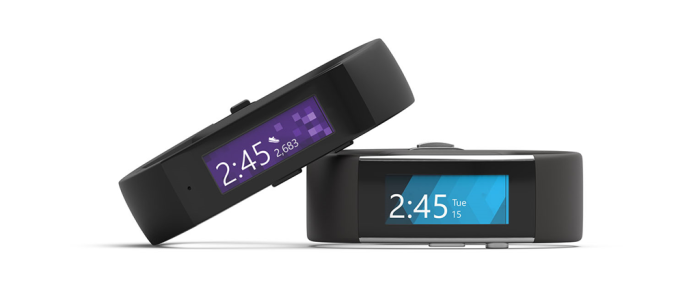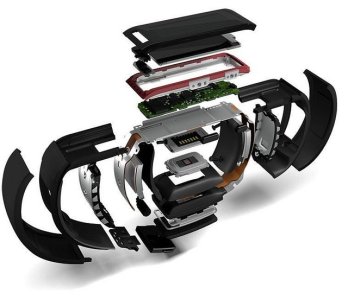
I’m going to get a little personal here. Not that long ago, I was, let’s not mince words, fat. I was well over 100 lbs. overweight. To be exact, I weighed 250 pounds. EVERYTHING I wore was a large. I had a 42-inch waist. Below is a photo of me.

I don’t take a lot of photos of myself but here’s the most recent full body shot of me. This is after I lost 50lbs. I’ve lost 25 lbs since then.

I’ve battled weight issues for a long time. I’ve either been fat or thin. And I genuinely don’t know why I gain weight, hold it for a while, then lose it for almost no reason whatsoever. I can have no fitness routine at all and be thin, then eat 1 pop tart and balloon up to the point where none of my clothes fit me anymore. Until the fitness bands and health apps came around there really wasn’t a way to monitor my activity & caloric intake without a pen and paper. FYI, I don’t keep paper money around because it gets lost & or destroyed. How do you think a notebook with scribblings of my diet/exercise routines faired? Then along came the various apps which helped a lot. I went from weighing 250 to 245-240. I had a pretty wide net of them. But they couldn’t do a lot. Because frankly, a phone as a fitness device is just a glorified pedometer. Enter wearables and the Microsoft band. The Microsoft Band was the only 1 that worked with my Lumia that was on par with what other fitness bands and some smartwatches did at the time. It allows me to basically micromanage my body. I track my sleep, my calories (when I could use it with the MSN health app to track my caloric intake) and workout routines. But all that isn’t why I initially bought the Band. I bought it as a companion device for my phone. It’s simple. It doesn’t run any apps. What it does is it kept me apprised of what’s going on with my phone without having to look at my device. I could control some functions. About the only thing, I could do is buy a cup of coffee with it. The fitness stuff was a bonus that I didn’t think I’d use on a regular basis.
View attachment band app.bmp
But when I started seeing my sleeping stats, my calories burned, etc, I started to care more about those health functions. I currently weigh around 180. And I’m still losing weight, getting in better shape and I’m still rocking the Microsoft Band. But I’ve got a problem with the Microsoft Band. As far as Microsoft is concerned, it doesn’t exist. Because Microsoft isn’t really a company that fights battles unless they’ve already won it. Microsoft band isn’t the #1 fitness band or even in the top 5 fitness bands/smart watches? So, they pretend it doesn’t exist. Windows Phone isn’t setting the world on fire? So, they do what Apple did with the Apple TV after it 1’st launched. Treat it as a hobby but then, unlike Apple they did nothing after that. Under Satya Nadella, Microsoft is a retreat and play nicely on other platforms while it almost completely disregards its own platform. Don’t believe me? Look at the mail/calendar app on windows then look at the outlook app on iOS or Android. Where do you see most Microsoft garage apps? Do you see them on windows as UWP apps? Do you see ANY in the windows store? “Windows 1’st or Windows best” right?
Microsoft keeps saying that Windows Mobile is important to their overall strategy. I believe that’s true. But the same goes for wearables. The Microsoft band isn’t exactly the Microsoft Spot Watch. This is important because it’s capable of being the perfect fitness monitor and device companion. Microsoft is fully capable of innovating. The question remains however, is Microsoft capable of reaching down a little deeper for a bigger set of balls to compete anymore? Should Microsoft get back into the wearables business as more than a hobby, I’ve got an idea of what I’d like to see from them. Starting with the hardware.

Surface Pulse:
Let’s do away with the Band name all together and ride the Surface coat-tails. In doing so, let’s keep with the design and engineering philosophy that comes with that brand name. Something that could be a category all to itself. Not just a fitness tracker or smartwatch. But a perfect companion device for phones, tablets, PCs, ETC. Currently, there are 2 main parts to the band. There’s the main part with the screen and then there’s the sensor on the latch. The Pulse, needs to be an all in one. Put the sensor right in the main housing of the device. This allows for 1 size fits all devices with customizable bands and straps. There should be 2 options for powering the pulse.
· QI wireless charging: Lots of Lumia devices do this already.
· Thermoelectric: Lots of watches do this. It wouldn’t be enough to keep the battery at 100% but this could be used to prolong the battery life.
· The point of this is to help make the device as water resistant as possible. The device itself shouldn’t even have buttons or dials.
Back to the wrist bands, Microsoft, I know you like partnerships. PLEASE SKIP THIS. Just make the connection for the wrist bands to be made by ANYONE. This is going to play a very important part because now we’re going to talk about what the device is going to be shaped like.
The current band is a curved plastic unit with a thin strip of glass that’s roughly a half inch tall and about two inches wide. This is probably why they couldn’t get windows to run on it. But rather than make Windows smaller, lets make the device a little bigger. What if it was a little over twice that size and turned on its head? So now when you hold your wrist upright, you have a device that’s 3 inches tall & 2 inches wide that curves around your wrist. Now we have a bigger screen and an overall bigger device to work with. Use an AmOled screen to save power and allow for glanceable details to be shown such as the time & a few app notifications. Now the pulse would be running a stripped down, device specific version of windows 10. This is not windows mobile or windows that runs on your Surface pro/book/studio or your Xbox. You will see tiles and tile groups. The interface will allow for being viewed in portrait and landscape. But what will be front and center is Cortana. You can get the time just by turning the screen off. Now if the pulse runs apps, does that mean I can run office and play games on it? This leads us into what the Pulse should not do/be.
1. It’s not a smartphone for your wrist. This shouldn’t be a gaming platform. Maybe like the Surface Dial it can be a peripheral for apps and games on the phone, PC/Tablet & Xbox (more on that later). But it shouldn’t be able to play games.
2. It shouldn’t run full blown apps & programs. At best, what it should be running would be something more akin to widgets for the active apps on your devices. Allow me to reply to things like messenger apps & social network reply’s and updates. But this shouldn’t be a full-blown app platform.
3. The Pulse needs to be a companion to primary devices like phones, tablets, PCs, Xbox and windows IOT devices first & a fitness tracker a close second. It should be sparingly used as a standalone device.
4. Storage shouldn’t be an issue. It should have enough space for the OS, Maps and some data relevant to the apps on your windows device. The closest thing to 3’rd party apps you’d be using on the device would be almost like a cross between widgets and googles apps on tap.
Keep what’s currently on the Microsoft band. The weather app, Messaging should be the skype app. Just combine messages & phone. Cycling, workout but lose guided workout (more on that later), outlook mail and calendar, alarm & sleep. Music controls, power options, quiet hours & settings should be accessible via edge gesture. Swipe out from the right to get them. Cortana would be available by swiping up from the bottom of the screen. Notifications would be a swipe from the right edge of the screen. The rest of the apps available would be based on the apps you allow from your windows 10 devices. Facebook, News, whatever the developer allows for. For most things like looking at photos, it would stream it via Bluetooth from whatever device associated with your account, it’s connected to and nearest. Earlier I said there are no buttons or dials on the Pulse. So how do you turn it on & off? When the screen is off (connected standby), double tap to wake it up. When the screen is on and you want to go back into connected standby, swipe down from the top of the screen. There really isn’t a reason to turn it off. But if you should need to & then need to turn it back on simply power the device off while not charging it either by Qi or wearing it. To power it back on, just plug it in or wear it and it’ll power back up.
Tap to pay and tap to pair are a must. This shouldn’t have Microsoft edge however. Just let Cortana handle searches. GPS is a must. Pulse should just communicate with the nearest device it’s paired to. There shouldn’t be a camera. It doesn’t need LTE but it should have Wi-Fi. Keep the Optical heart rate sensor, (Formerly3-axis) 8-axis accelerometer/gyro, Gyrometer, GPS (for running, cycling and navigation when maps are downloaded), Ambient light sensor, Skin temperature sensor, UV sensor, Galvanic skin response, Barometer and add a Proximity Sensor, Gyroscope, Magnetometer & SensorCore. The only things it shouldn’t have is a camera, speaker & a microphone.
So, what can this device do? Imagine your phone rings. You see who’s calling. But you don’t have to touch the device. By using gestures, you can lower your hand to dismiss the call or bring it up to your ear to answer it (No, there are not speakers built into it. More on that later). In addition to using it for security as you can now with any Bluetooth device for windows 10. You can use it as a peripheral in almost Kinect like ways. Maybe 1 extra sensor that can allow the device to sense the tendons in your wrist to tell what your fingers are doing. So, let’s say I bring my wrist to chest level & I tap my palm with my index finger. That triggers it to go to music controls. From there I can gesture to lower or raise the volume or move to the next or previous song. Other fingers correspond to other actions on the Surface Pulse. This can be further customizable for other functions with your phone or pc. If the Surface Dial has shown us anything, a new peripheral can attract developers. So, these gestures can be made relevant to an open app on a device then set by the developer. Or Imagine doing a gesture, turning your wrist upside down and hovering over a table while you’re using your surface. While doing this, you have your index & middle finger extended like you’re making a peace sign. Now, because of the gestures you’ve made and the actions you’re doing with your fingers, you have a virtual mouse. For gamers, this would almost be like a small cross between a Kinect and a controller. Microsoft can even sell an extra accessory. Something small like a small, Bluetooth joystick like what some VR sets come with.

But earlier on I said this device has no speakers. Not entirely true. What about if it came with a Bluetooth headset? Now they can’t be too expensive. The LG Tones can cost as little as $50 and they get long battery life. These headsets wouldn’t have controls on them except for the power button, because they are controlled by the Pulse. They’d be chargeable by USB-C & Qi. You’d have your choice of in ear and over ear. Pairing would be handled by the Pulse rather than at the headset.
The Microsoft Band app.
View attachment band app.bmp
Since the band as far as this piece is concerned is dead. Then we can stop calling it the Microsoft Band app. But don’t go back to calling it the Microsoft Health app. For right now let’s call it by Bings initial code name: Kumo (That and no one apparently owns the site). This would have the added be added benefit of not being strictly being locked to the Surface Pulse. Which leads me to my next point. Allow it to be used with other fitness trackers. Allowing it to be used by other fitness trackers allows many things. It lowers the barrier to entry for device makers to support windows because for all intents and purposes, they don’t have to. It lowers the barrier to entry for users as well. Their fitness tracker of choice if it’s not the Pulse, is available for windows 10 devices. Furthermore, this allows for Kumo to be a fitness social network by allowing people to compete against each other with universal data points: Push ups, sit ups, steps taken, etc. Not to mention it buys good press and the best experience would still be possible would still be the Pulse. I don’t need to get into what the benefits of having a social network would mean. If you don’t know the possible ad revenue streams, then I would have to sincerely question why are you even in software. But this can be easily done for Microsoft as they already have the means of getting ads in front of users. Use Azure as the back bone. You wouldn’t be in direct competition with your “partner” Facebook. But you would add to your revenue by filling a gap left behind by Facebook because it’s too much of a niche for them to dedicate time to fill.
This app will allow you to set the background and layout of the pulse, the tile group layout along with the tiles as the current band app does now. It will give you your stats; calories burned, sleep, steps, etc. But it’ll also do a few other things. Kumo, as an app/service/social network will compete against services like Strava for cycling and running. By letting users show the miles they ran, jogged, cycled and challenge their friends and various other people that are in their skill level. It’ll also compete against lose it. MSN health used to be able to tell you how many calories was in a meal just by entering it. Whether you where cooking it from scratch and allocating the portions yourself or if it was a store-bought meal or something you bought from a restaurant. Add the ability to scan items and use location to help input what meals the user is logging in. Allow for smart scales to connect to it and you have a fully developed featured social network based around fitness. Apps like Lose it and Strava are not and for the foreseeable future will not be available as an app in the windows store. Let alone a UWP. And apps like Runtastic are leaving. So, until they are, users shouldn’t be left wanting for similar functionality.
You know what my favorite thing to take into the gym is. My Surface Pro. It’s honestly my favorite fitness tool. Because with the apps available, I can select the workout I want and the screen is big enough that I can see what I need to do. So, as I said earlier, pull guided workouts from the device. The pulse when used by itself for workouts should be running, walking, golfing, cycling & generic workout. A guided workout should be done with the phone or the PC. This allows for Microsoft to build in features from properties they already owns like Kinect fitness. Finally, both the device and the app need to strongly benefit from 2 things Microsoft does well. 1 is calendars. For scheduling workouts & tracking progress. The other is Cortana. Because she’s connected to so many things: your phone, tablet, etc. As I mentioned earlier, Microsoft has several apps that center around 1 thing. This is the usual Redmond redundancy. Build in Microsoft health vault and health vault insights. This part WILL NOT BE SHARED TO THE SOCIAL NETWORK ASPECT OF KUMO. This allows for users to make their health data portable.
So there you have it. The Surface Pulse! It’s a smartwatch that’s the perfect companion device for your windows 10 devices be it a Windows Phone, Tablet/PC, Xbox, IOT or the range or Cortana devices like the Harmon Karmon Invoke. A fitness tracker that can collect your health data, analyze it & allow you to share it. And it’s a peripheral for your choice of gaming or productivity. It’s a smarter bluetooth headset. And because it’s made with some of the internals as the current Band 2 and the Lumia 520 minus the LTE, camera & microphone, it can be made on the cheap & sold at a bargain. If you have some of your own idea, leave them in the comments. If you agree with me in anyway, do me a favor. Tweet this article at:
https://twitter.com/joebelfiore
https://twitter.com/panos_panay
https://twitter.com/tmyerson
https://twitter.com/donasarkar
AND last but not least
https://twitter.com/SatyaNadella
Originally posted on https://metroheads.wordpress.com/2017/04/15/getting-microsoft-wearables-back-in-shape/


